8 incredibly useful yoga props for your home practice
The right tools can deepen your flow—and you may already have some of them.
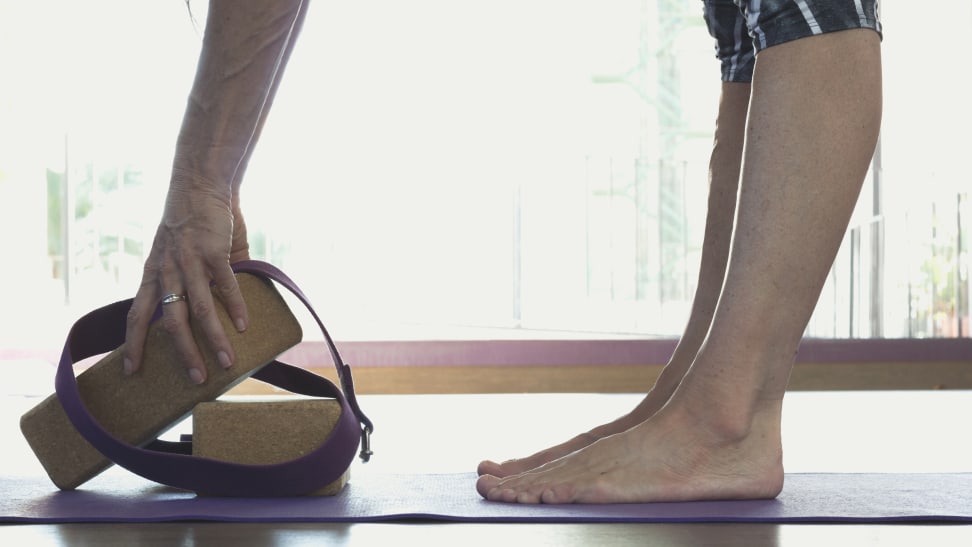 Credit:
JosuOzkaritz
Credit:
JosuOzkaritz
Products are chosen independently by our editors. Purchases made through our links may earn us a commission.
Whether you frequent yoga classes or just hit up the occasional session, you may think of things like blocks, straps, and bolsters as studio-only accessories. But as a devoted yogi and yoga teacher, I’m a huge advocate of using props in your home practice.
If you’re a beginner to yoga, a well-placed block or blanket can help you make poses more accessible. They can give your hands get more height in folding poses, and they can help you stabilize your body in balancing poses. And if you’re an experienced yogi, certain tools can help you reach new places—whether that means deeper stretches or more supported backbends. Having a mat or blanket also turns any parking lot or grassy park into a place to practice, and adding bolsters and blankets to restorative poses allows you to really sink in.
All this is to say, props will benefit your yoga practice no matter what shape it takes. And if you’re not sure where to start, we’ve got you covered—including easy substitutes for some items, using items you probably already have at home, which you can turn to if you’re in a pinch.
The tools you choose are up to you. But here’s what I think you should start with, in order of necessity.
1. A yoga mat and towel for a comfier flow
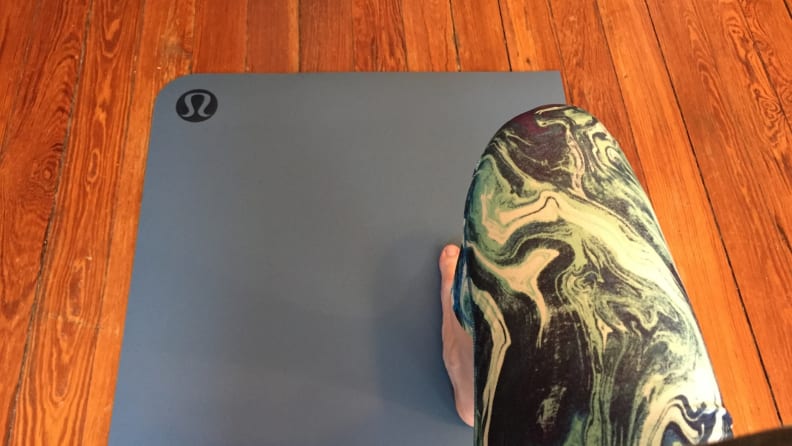
I think everyone should have a trusty yoga mat.
The first—and most important—thing I recommend is a good yoga mat. Having solid flooring also helps, as it provides more stability, but even with carpet, a reliable yoga mat will elevate your practice. The mat provides a smooth surface for you to flow through poses and salutations without slipping or getting rug burn—and a truly great mat may even help you get excited for you to start your practice.
I prefer mats that have a bit of grip to help you stay put in poses even when your hands and feet become sweaty—when searching for mats, look for one that’s described as anti-slip or “grippy” but still has cushion. Or, you can go straight for our favorite yoga mat from Lululemon, which is my own yoga companion. The 5mm thickness supports my wrists and ankles without being too cushy under my feet in poses like triangle and pyramid. It always lays flat for me and is easy to clean with a cloth and water. (If you don't feel like shelling out Lululemon cash, we also like the Amazon Basics mat.)
If you’re planning on doing hot yoga or live in a humid climate, consider purchasing a mat towel—Lululemon makes a great one—which absorbs sweat, gives you additional grip, and protects your mat’s surface.
DIY replacement: Unless you have a perfectly cushy, grippy floor at home, it’s probably a good idea to go ahead and buy a yoga mat. But don’t fret if you don’t have a fancy yoga towel—any old thing made of terrycloth should work on your mat during sweatier practices. It won’t work as well as designated yoga towels, since those have more grip and sweat-wicking qualities, but it’ll do if you’re in a pinch. And, if you’re practicing on grass or sand, you can also use a towel or household blanket in place of a mat.
- Get The Reversible Mat from Lululemon for $78
- Get the Amazon Basics 1/2-Inch Extra Thick Exercise Mat from Amazon for $21.49
- Get The Towel from Lululemon for $38
2. Blocks to bring the floor closer
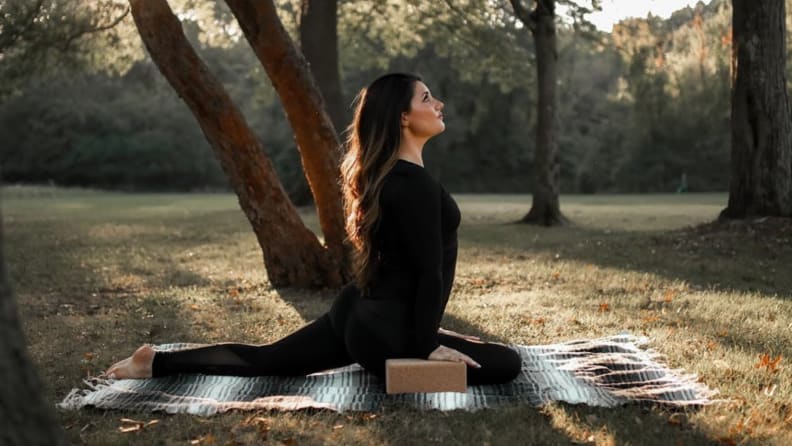
Keep a blanket in your car or tote to turn any ground into a place to practice.
My favorite addition to a practice is blocks. They’re versatile and provide a lot of “feedback” for your body, or tactile clues that help you get and keep your body where it needs to be. For example, in a table pose on your hands and knees, it’s beneficial to have wrists under shoulders and knees under hips. However, when you’re in the pose, it can be hard to tell if you’re measured up. Placing a block behind one wrist and in front of the opposite knee as a measurement tool can help you make the most of poses. Once you begin to cat and cow your spine, the blocks may move or even tip over; this feedback shows you where your body is really moving, not just where it feels like it is.
There are three main types of blocks: foam, cork, and wood. Foam blocks are light and portable, making them great for people who practice on-the-go. They work well for restorative poses (like placing the blocks below your shoulder blades and leaning back or in half pigeon) because they are soft to lean on. Cork blocks are a great middle ground, as they’re sturdy but still have some give. They work well for placing below your legs or arms to help you stay in a pose like half moon longer. Wood blocks are the most dense and the least comfortable. They’re best for helping you find 90-degree angles and articulating poses you’ve already “mastered” in your practice.
I have four Everyday Yoga cork blocks that I use in my daily practice. I always use at least one to measure myself in poses or provide support. When I have time for a lengthier practice I incorporate several blocks into a supported bridge or use them along with my yoga chair (mentioned below).
DIY replacement: Books are the best replacement for a block, especially hardcover books like textbooks and cookbooks (or maybe the last Harry Potter book). If you’re only looking for something to measure 90 degrees—say, in table pose or your front leg in Warrior I—you could use a box of pasta, cereal, or a shoebox.
- Get the Gaiam Foam Yoga Block from Amazon for $6.69
- Get the Everyday Yoga Cork Block from Yoga Outlet for $15.98
- Get the Everyday Yoga 4 Inch Wood Block from Yoga Outlet for $13.98
3. Straps to give yourself adjustments
Straps are wonderful for giving your body boundaries. You can use them while learning arm balances to keep your wrists and elbows shoulder-width distance. Straps are also useful in restorative poses because they can help you feel secure in a pose.
When you’re looking for a strap, consider going for a quick-release option, which means it has a buckle that allows you to switch between different positions with the strap with ease. I like Katonah Yoga's strap, which is made of cotton material that feels durable enough to support my limbs but doesn’t cut into the skin the way some cheaper straps can. Plus, its clip makes the strap easier to click together, tighten while in a pose, and release than ring-closure straps.
DIY replacement: Towels can also replace straps for shoulder flossing or creating some resistance, say, in a forward fold or overhead in a lunge or warrior pose. (Hot tip: roll the towel from one corner and hold diagonal ends to get the most length.)
Get the Yoga Strap from Katonah Yoga for $16
4. Bolsters, cushions, and sandbags to encourage relaxation
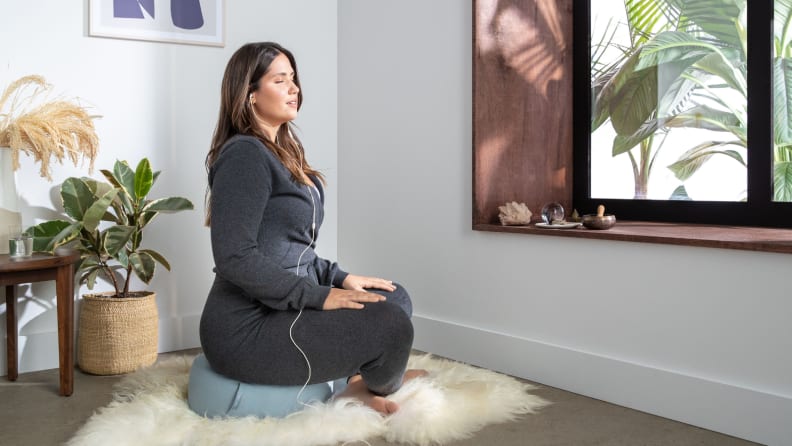
I love Tuft & Needle's meditation pillow.
Things like bolsters, blankets, and meditation cushions can all be used to provide support during your practice—usually, they’re used to make seated and reclined positions more comfortable, which helps you stay in the poses longer. If you’re looking to sink into a slow practice, I recommend working with these types of props to make the most out of movement focused on deep relaxation.
When you’re shopping for bolsters or cushions, consider treating yourself to something nice. I recently tested out the Tuft & Needle meditation cushion, and love it. I plan to work on my meditation and pranayama (breathwork) practice this year, so I’m thankful I have a high-quality, comfortable place to do it. Another great option is Everyday Yoga's rectangular bolster, which contains dense yet pliable foam that reviewers say provides the right level of support for everything from meditation to propping up the hips during pigeon pose.
Sandbags can be used to weigh hands or ankles down during savasana. They may seem excessive, but the effect they give is akin to that of a weighted blanket—which is to say, once you practice with one, you won’t want to go back. Sandbags come in various weights and sizes, and you can buy the bags unfilled to further customize for your specific needs. My go-to sandbags are the 10-pound sandbags from Hugger Mugger—some sand may escape from the bag over time, but not at a fast enough rate to make the bag seem flat.
DIY replacement: Piled-up pillows and blankets can replace a bolster or cushion, and they make yin poses even cozier. And, if you already have a weighted blanket, that can serve as a great dupe for a sandbag.
- Get the Meditation Cushion from Tuft & Needle for $80
- Get the Everyday Yoga High Impact Rectangular Bolster from Yoga Outlet for $44.98
- Get a 10-pound Hugger Mugger Sandbag from Yoga Outlet for $25.98
5. A yoga wheel to improve balance
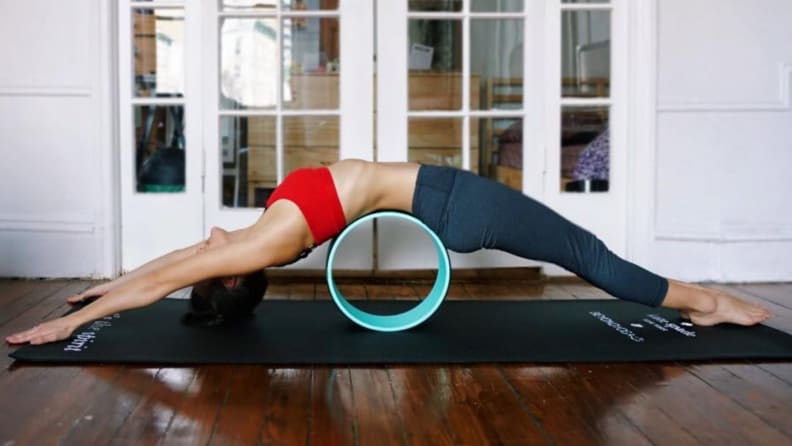
Test out your balance with a yoga wheel.
Yoga wheels are tools to help improve balance and can help increase flexibility—they can be used lengthen tough-to-stretch spots like the back and build strength in the core by balancing on one when you're in a plank. Since you may use the wheel on your spine and feet, you'll want it to be supportive and durable enough to support your body weight and wide enough to feel comfortable. The Reehut wheel has more than 2,000 reviews on Amazon, with customers raving about the amount of support and comfort it provides.
DIY replacement: It's tough to replicate a yoga wheel with something you have around the house, as you need something that curves the right way and is able to support you. You can find some DIY instructions for yoga wheels on Pinterest—most of which involve PVC pipes, old yoga mats, and some power tools. If you like getting crafty, it could be just the challenge for you; otherwise, it might be best to go for a store-bought option.
Get the Reehut Yoga Wheel from Amazon for $29
6. A dowel to lengthen your spine
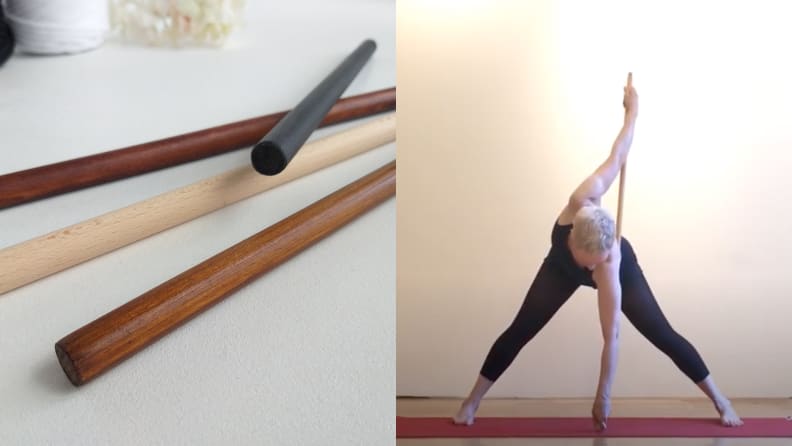
A dowel can help you maintain form in difficult postures.
A dowel is basically a long wooden stick that you can use during your practice to maintain alignment during deep stretches. You can use one to work on shoulder mobility by holding the handle in both hands with your grip the same as if you were holding onto a bike’s handlebars. You then lift the dowel over your head and behind your back and then up, over, and in front of you again. Doing this each day will increase your range of motion and help combat the back soreness associated with sitting for long periods of time.
If you want to try out a yoga pole sequence, my favorite place to get a dowel is Lowes. You can get one there for less than $5 and, if you go in person, you can have someone there chop it down to the right size for you, which is slightly longer than your wingspan. If you know the length you need, you can also order them online from Etsy in a range of lengths.
DIY replacement: Have any spare wooden curtain or tapestry rods? If so, you basically already have a dowel. If not, both brooms and mops have dowel-like handles.
7. A yoga chair to support your inversions
A yoga chair looks like a standard metal folding chair, but it doesn’t have a back. This provides support—as well as something to grab onto—as you get into inverted postures like headstand or even downward dog. A reliable yoga chair can be purchased from YogaLifeStyle on Etsy. Reviewers say it's sturdy yet lightweight and helps them feel safe as they go deep into poses.
If you’re buying a chair, you’ll also want a set of cork blocks so you can prop up two of the legs to assist with inversions; the foam blocks will not be safe for this purpose. The chair can be used in numerous ways, from inversions to restorative poses, so it’s also nice to have blankets and straps on hand to get the most out of the versatility. If you’re curious about all the uses, buy a copy of this popular Iyengar Yoga book that provides instructions for each pose you can do with the chair.
DIY replacement: Instead of a chair, you can use the edge of a bed or countertop to help you find length in your spine. The wall is always a great prop too; it’s supportive, flat, and can handle your full weight in practically any pose. It also (hopefully) is a 90-degree angle, which can help you stay in alignment when twisting or balancing. And, for some poses that don't require threading your upper body through the portion without the back—like simple feet elevations—a regular chair can work.
Get the YogaLifeStyle Pune Yoga Chair from Etsy for $85
8. Clothing that feels good when you move in it
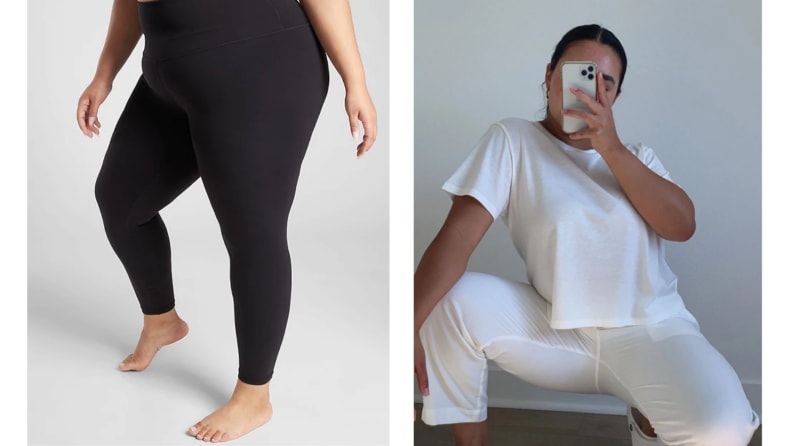
I get most of my yoga clothing from Athleta and Girlfriend Collective.
I prefer a loose top and tighter leggings when I practice so I can use blocks without them catching on thicker fabric, but you’re the expert on your body when it comes to your yoga outfit. Athleta, Lululemon, Old Navy, and Girlfriend Collective make some of our favorite workout apparel, but as long as you have something comfy and stretchy, you should be good to go.
My go-to yoga pants are the Ultra High Rise Elation Tights from Athleta. They’re soft and opaque without being pinchy. My favorite top is the Gia Crop Tee from Girlfriend Collective. It’s lightweight, soft, and, as a bonus, made from recycled water bottles.
So, my biggest pointer for yoga clothing is this: Don’t overthink it! Wear something you can move and breathe in. If you’re worried your pants are see-through or your top is too low-cut, opt for clothing that is a bit thicker and more supportive. If you sweat a lot (like me) choose sweat-wicking fabric, or wear a tank top under a shirt that you may decide to take off part-way through a class. Yoga is a versatile workout, so your clothes can be too.


